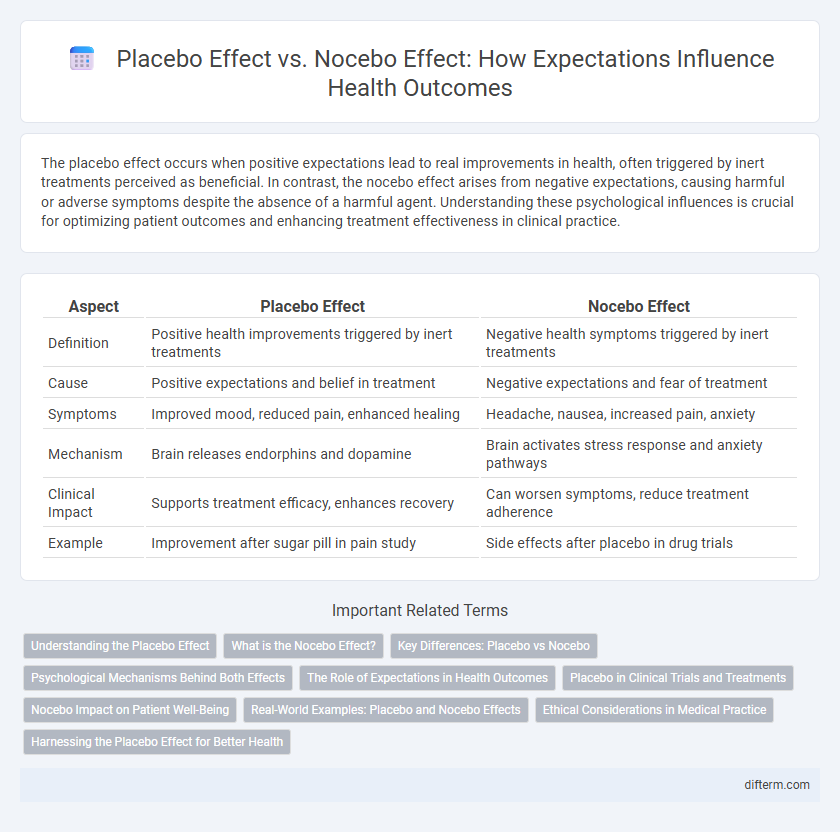The placebo effect occurs when positive expectations lead to real improvements in health, often triggered by inert treatments perceived as beneficial. In contrast, the nocebo effect arises from negative expectations, causing harmful or adverse symptoms despite the absence of a harmful agent. Understanding these psychological influences is crucial for optimizing patient outcomes and enhancing treatment effectiveness in clinical practice.
Table of Comparison
| Aspect | Placebo Effect | Nocebo Effect |
|---|---|---|
| Definition | Positive health improvements triggered by inert treatments | Negative health symptoms triggered by inert treatments |
| Cause | Positive expectations and belief in treatment | Negative expectations and fear of treatment |
| Symptoms | Improved mood, reduced pain, enhanced healing | Headache, nausea, increased pain, anxiety |
| Mechanism | Brain releases endorphins and dopamine | Brain activates stress response and anxiety pathways |
| Clinical Impact | Supports treatment efficacy, enhances recovery | Can worsen symptoms, reduce treatment adherence |
| Example | Improvement after sugar pill in pain study | Side effects after placebo in drug trials |
Understanding the Placebo Effect
The placebo effect occurs when patients experience real improvements in health after receiving a treatment with no therapeutic value, triggered by their expectations and beliefs. Understanding this phenomenon reveals the brain's powerful role in influencing physical outcomes through psychological mechanisms such as conditioned responses and neurotransmitter release. Research in neurobiology shows that placebo responses can activate endogenous opioid pathways and modulate pain perception, underscoring the significance of patient mindset in clinical outcomes.
What is the Nocebo Effect?
The nocebo effect occurs when negative expectations or beliefs about a treatment cause harmful or adverse symptoms, despite the treatment being inert or harmless. This psychological phenomenon can lead to increased pain, side effects, or worsening conditions solely due to anticipation of negativity. Understanding the nocebo effect is crucial for healthcare providers to improve patient outcomes by minimizing suggestive negative communication.
Key Differences: Placebo vs Nocebo
The placebo effect occurs when a patient experiences positive health outcomes after receiving an inert treatment, driven by expectations of benefit. In contrast, the nocebo effect results in negative symptoms or side effects triggered by negative expectations or beliefs about a harmless intervention. Key differences lie in the direction of the psychological influence on physical health, with placebo enhancing and nocebo impairing patient outcomes despite both involving inert substances or procedures.
Psychological Mechanisms Behind Both Effects
The placebo effect arises from the brain's expectation of positive outcomes, releasing neurotransmitters like endorphins that enhance healing and symptom relief. In contrast, the nocebo effect is driven by negative expectations, triggering anxiety and stress responses that can amplify pain and worsen symptoms. Both effects demonstrate the powerful influence of cognition and perception on physiological health through complex neurobiological pathways.
The Role of Expectations in Health Outcomes
Expectations significantly influence health outcomes by activating the brain's neurobiological pathways, where positive expectations trigger the placebo effect, promoting healing and symptom relief. Conversely, negative expectations can induce the nocebo effect, exacerbating symptoms and hindering recovery through anxiety and stress responses. Understanding the psychological mechanisms behind expectations enables healthcare professionals to enhance therapeutic efficacy and mitigate adverse effects.
Placebo in Clinical Trials and Treatments
The placebo effect plays a critical role in clinical trials by providing a baseline to measure the efficacy of new treatments, as patients receiving inert substances often experience real improvements due to psychological and physiological responses. This phenomenon highlights the brain's power in modulating pain, symptoms, and overall health outcomes, influencing trial endpoints and treatment evaluations. Understanding the placebo effect allows researchers to design more accurate studies and develop therapies that harness mind-body interactions for enhanced patient care.
Nocebo Impact on Patient Well-Being
Nocebo effects significantly impact patient well-being by inducing negative symptoms triggered by negative expectations or beliefs about a treatment. Research shows that patients experiencing nocebo responses report increased anxiety, heightened pain perception, and decreased overall treatment effectiveness. Managing communication and patient expectations is critical to minimizing nocebo-related harm in clinical settings.
Real-World Examples: Placebo and Nocebo Effects
Placebo effects are demonstrated in clinical trials where patients receiving sugar pills report symptom improvement due to positive expectations, such as reduced pain or anxiety. In contrast, nocebo effects occur when patients experience adverse symptoms like headaches or nausea after inert treatments because of negative beliefs or fear. Real-world examples include patients experiencing side effects from medications known to have mild risks solely because they expect them, highlighting the powerful influence of mind over body in health outcomes.
Ethical Considerations in Medical Practice
The ethical considerations surrounding the placebo effect versus the nocebo effect in medical practice revolve around informed consent and patient autonomy. Clinicians must balance the use of placebos to harness beneficial psychological effects without deceiving patients, while minimizing nocebo-induced harm caused by negative expectations. Transparent communication and ethical guidelines are essential to ensure trust and uphold professional integrity in healthcare settings.
Harnessing the Placebo Effect for Better Health
Harnessing the placebo effect leverages the brain's power to trigger real physiological improvements through positive expectations and beliefs. Studies reveal that placebo-induced responses can enhance pain relief, boost immune function, and improve treatment outcomes without active medical intervention. Understanding the neural mechanisms behind placebo benefits enables healthcare providers to ethically integrate this phenomenon into patient care to optimize therapeutic efficacy.
Placebo Effect vs Nocebo Effect Infographic

 difterm.com
difterm.com